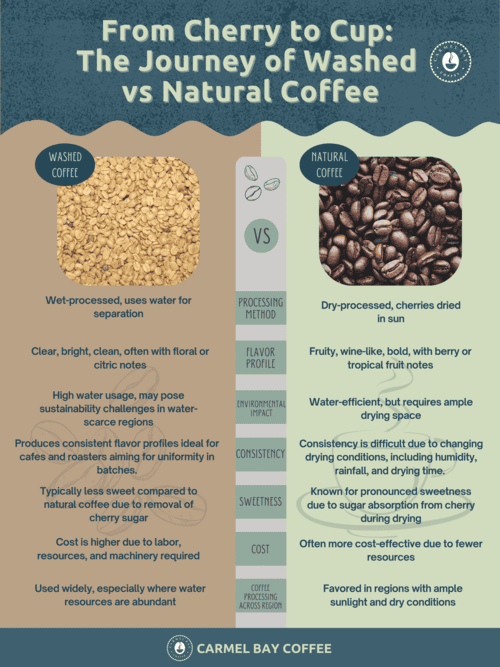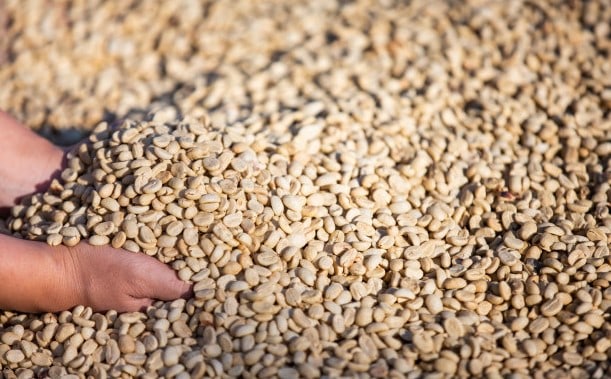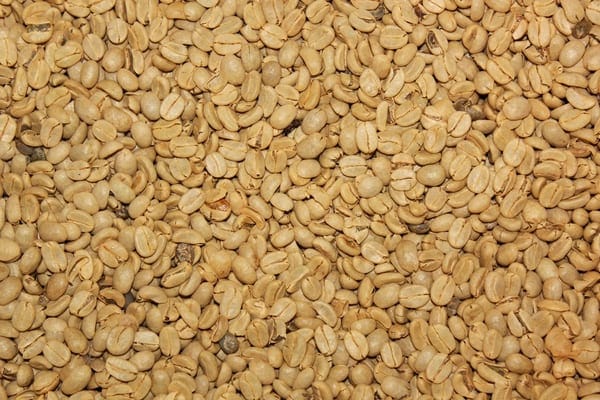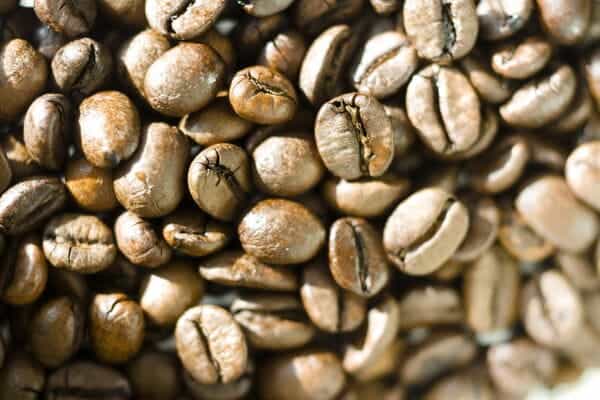For coffee lovers worldwide, the journey from bean to cup is fascinating. Have you ever sipped your morning brew and pondered the story behind its flavor? Let’s explore the intriguing world of “washed vs. natural processed coffee” processing and uncover those beans’ journey to reach your cup.
Washed coffees, often found in specialty coffee shops, present a clearer, more defined flavor profile, allowing the intrinsic characteristics of the coffee seed to shine.
On the other hand, coffees that undergo the dry process, where moisture content plays a crucial role, can offer a bolder, fruitier taste influenced by the sugars and compounds from the coffee fruit. It’s akin to tasting two wine varieties; each has unique notes and nuances, with some coffees even exhibiting higher acidity.

What is Coffee Processing?

Coffee processing is the intricate journey that raw coffee cherries embark upon to become the aromatic green beans that roasters cherish. At its core, it’s a series of steps designed to extract the coffee seed from the coffee fruit while also influencing the final flavor profile of the coffee through different processing methods.
When we talk about coffee cherries, we’re referring to the fruit of the coffee plant. Inside each cherry are the seeds we commonly refer to as coffee beans.
But getting from cherry to bean isn’t as simple as it sounds. The process involves several stages, from picking the cherries to drying them on brick patios and eventually roasting them. Each stage has its own set of procedures, and the choices made during these stages, especially concerning moisture content, can significantly impact the final brew’s taste, aroma, and overall quality.
Importance in Flavor Development
Think of coffee processing as the unsung hero in the world of coffee just as a chef’s preparation can transform raw ingredients into a gourmet dish, coffee processing can elevate or undermine the inherent flavors of the coffee bean.
The coffee cherry’s outer layers contain sugars and other compounds, including its pulp and mucilage. These compounds can influence the bean’s flavor depending on the processing method. For instance, allowing the bean to dry within the cherry (as in natural processing) can infuse it with some of the fruit’s sweetness. Conversely, removing the cherry and mucilage before drying (as in washed processing) can produce a bean with a cleaner, more defined flavor profile.
Moreover, the duration and conditions of the drying phase can also play a role. Too much moisture can lead to mold, while too little can result in over-dried beans. Both scenarios can adversely affect flavor.
In essence, coffee processing is akin to the art of sculpting. Just as a sculptor chisels away to reveal the masterpiece within the stone, the coffee processor employs various techniques to unveil the bean’s hidden flavors, aromas, and characteristics.
Whether washed, natural, or something in between, the method chosen can amplify the bean’s inherent qualities or introduce new, unexpected notes, making each cup of coffee a unique sensory experience.
What is Washed Coffee?

Washed coffee, frequently called wet-processed coffee, is a method that meticulously uses a water tank to separate the coffee seed from its surrounding cherry and mucilage.
This process begins with the immersion of the coffee cherries in a water tank, where the ripe ones sink and the unripe or defective ones float. After this, the cherries are mechanically de-pulped, leaving the beans covered in a sticky mucilage residue.
These beans are then fermented in fermentation tanks to break down this mucilage.
Once fermentation is complete, the beans are washed clean, revealing the parchment-covered coffee beans. These beans are dried in the sun or using mechanical dryers.
The washed method, while demanding in terms of labor and resources, is praised for producing coffee beans that truly reflect their inherent flavors. The bean’s pure taste shines through without the influence of the cherry’s sugars and mucilage.
Pros of Washed Coffee
Consistency: One of the standout advantages of washed coffee is its consistency. Because the process is controlled and the beans are cleaned of their mucilage, the resulting batches of coffee have a uniform flavor. This benefits coffee roasters and cafes that aim to provide consistent coffee beans to their customers.
Clarity: Washed coffee is often likened to a clear, high-definition image. The distinct flavors allow coffee enthusiasts to discern the subtle notes and characteristics unique to the bean’s origin, variety, and terroir. This clarity is especially appreciated by those who enjoy single-origin coffees, aiming to taste the nuances of a specific region or farm.
Cons of Washed Coffee
Water Usage: As the name suggests, washing requires significant water. Water is crucial from the initial separation of ripe cherries to the fermentation and final washing. This method can pose environmental and sustainability challenges in regions where water is scarce or where conservation is a priority.
Cost: The machinery for de-pulping, the tanks for fermentation, and the extensive use of water all contribute to the higher costs associated with washed coffee. Additionally, the manual labor required to monitor the fermentation process, wash the beans, and ensure they dry evenly can make this method more expensive compared to others. As a result, washed coffees can sometimes command higher prices in the market.
You might be curious about how to experiment with these beans in your own kitchen. If you want to craft a unique flavor profile by combining different beans, check out our guide on How To Mix Different Types Of Beans To Create Your Own Blend. Dive in and discover the art of blending to create a cup that’s uniquely yours!
What is Natural Coffee?

Natural coffee, often called dry-processed coffee, is one of the oldest methods of coffee processing. It involves laying out the whole coffee cherries to dry under the sun, typically on raised beds or patios. The cherries are turned regularly throughout the drying process to ensure even drying. Once dried, the outer layers of the cherry are mechanically removed to reveal the coffee bean inside.
This method allows the beans to remain in contact with the cherry’s sugars and pulp for an extended period. As a result, the beans can absorb flavors from the fruit, leading to a coffee profile that’s often described as fruity, wine-like, or even syrupy.
Pros of Natural Coffee
Sweetness: One of naturally processed coffee’s most distinctive characteristics is its sweetness. As the coffee bean remains encased within the cherry during drying, it can absorb some of the fruit’s natural sugars. This imparts a pronounced sweetness to the coffee, often accompanied by fruity or berry-like notes.
Environmentally Friendly: Natural processing is notably more water-efficient than the washed method. The water footprint is significantly reduced since there’s no need for fermentation tanks or multiple washes. Additionally, the infrastructure required for natural processing is relatively minimal, often just requiring open spaces or raised beds for drying. This makes it a more sustainable choice in regions where water is a precious resource or where the infrastructure for wet processing isn’t available.
Cons of Natural Coffee
Inconsistency: One of the challenges with natural processing is achieving a consistent flavor profile. Because the beans are dried within the cherry, external factors like humidity, rainfall, and drying duration can influence the final taste. Two batches of naturally processed coffee from the same farm can taste noticeably different if the drying conditions vary.
Risk of Over-Fermentation: The line between perfect fermentation and over-fermentation is thin in natural processing. If the cherries aren’t turned regularly or if they’re exposed to moisture, there’s a risk that the beans inside can over-ferment. This can introduce off-flavors to the coffee, ranging from slightly tanginess to sour or fermented notes. Monitoring the drying cherries closely and ensuring they’re protected from unexpected rain or moisture is crucial to prevent this.
Washed vs. Natural Coffee
Flavor Profiles
The processing method can be a game-changer in terms of flavor in the world of coffee.
Washed Coffees: These are often described as the “purists” in the coffee realm. The process of washing away the cherry and mucilage allows the intrinsic flavors of the bean to shine through without interference.
As a result, washed coffees often present a clearer representation of the terroir – the unique combination of soil, altitude, and climate of the region where the coffee was grown. This clarity translates to flavors that are bright, clean, and crisp. In some washed coffees, you might find floral, citric, or even tea-like notes.
They’re like a clear window into the soul of the coffee bean, allowing drinkers to discern subtle nuances and characteristics.
Natural Coffees: On the other hand, are the wild cards. The prolonged contact with the cherry’s sugars and pulp imparts flavors that can be bold and unexpected.
Natural coffees can be fruity, boasting notes of berries, tropical fruits, or even dried fruits. Some can have a wine-like quality, reminiscent of certain red wines in their depth and complexity. And yes, if you’ve ever sipped a coffee and been reminded of blueberries or strawberries, you’ve likely experienced the enchanting effects of natural processing.
These coffees are like a vibrant painting, where the bean and the cherry collaborate to create a vivid tapestry of flavors.
Once you’ve selected your preferred beans, it’s essential to store them correctly to maintain their freshness and flavor. For expert advice on preserving the integrity of your beans, don’t miss our guide on Tips To Storing Coffee the Right Way. Ensure every cup you brew is as delightful as the last!
Environmental Impact
The debate between washed and natural coffee isn’t just about flavor; it also extends to their environmental footprint.
Washed Coffee Environmental Impact
The primary environmental concern with washed coffee is water consumption.
The process requires significant amounts of water, from the initial separation of cherries to the fermentation and final washing.
This method can be less than ideal in regions where water is scarce or where water conservation is crucial. Moreover, if not treated properly, the wastewater produced can harm local waterways due to its high organic content.
Natural Coffee Environmental Impact
While it scores points for being water-efficient, natural processing has challenges. This method requires ample space to spread out the cherries for drying. This can be a constraint in regions where land is at a premium. The extended drying times can make the beans more vulnerable to unexpected weather changes, like rain, which can ruin entire batches. However, from a water conservation perspective, natural processing is a clear winner.
When it comes down to it, both methods have their pros and cons when it comes to environmental impact. The choice often boils down to regional resources, infrastructure, and the priorities of the coffee producers.
In the grand tapestry of coffee, both washed and natural methods contribute unique threads, weaving together a diverse and rich landscape of flavors and stories. Whether you lean towards the clarity of washed or the boldness of natural, there’s no denying that understanding these processes adds depth to every sip.
FAQs – Washed vs. Natural Coffee
Most Common Coffee Processing Method
Washed and natural are both widely adopted methods in the coffee industry. Their choice often hinges on the region where the coffee is grown. For instance, the washed method might be more prevalent in areas with abundant water resources.
Conversely, in regions where water is scarce or there’s ample sunlight for drying, natural processing might be the go-to method. Infrastructure, local expertise, and market demand can also influence the processing method choice.
Environmental Impact: Which Method is Better?
Natural processing is notably water-efficient, making it a sustainable choice in regions where water conservation is crucial. However, it requires more space for drying the cherries.
Washed processing consumes more water while producing a consistent and clean flavor profile. But with technological advancements, modern washed processing techniques have become more land-efficient and environmentally friendly.
The Cost Factor: Why is Washed Coffee Pricier?
The washed method is often more labor-intensive and resource-heavy. From using machinery to depulp the cherries to maintaining fermentation tanks and ensuring a consistent water supply, the costs add up.
Additionally, the meticulous nature of the process, which involves monitoring and multiple stages, requires more hands on deck. This combination of labor, resources, and machinery often results in a higher price point for washed coffee than its naturally processed counterpart.
Coffee Processing Methods Across Regions
The choice of coffee processing method isn’t universal across all coffee-growing regions. Factors such as climate play a significant role. For instance, regions with dry climates might favor natural processing due to the abundance of sunlight for drying.
Tradition also weighs in; some regions have a long-standing history with a particular method, making it a part of their coffee culture. Additionally, available resources, both in terms of infrastructure and natural resources, can dictate the choice of processing method.
Wrapping Up Washed vs. Natural Coffee
Whether you prefer the fruity notes of a natural coffee or the crisp clarity of a washed one, understanding the processing can deepen your appreciation for that morning cup. So, next time you sip, take a moment to ponder the journey of those beans.
For washed processed coffee beans, you can take a look at Smokin Beans. They also offer Natural processed beans here.


